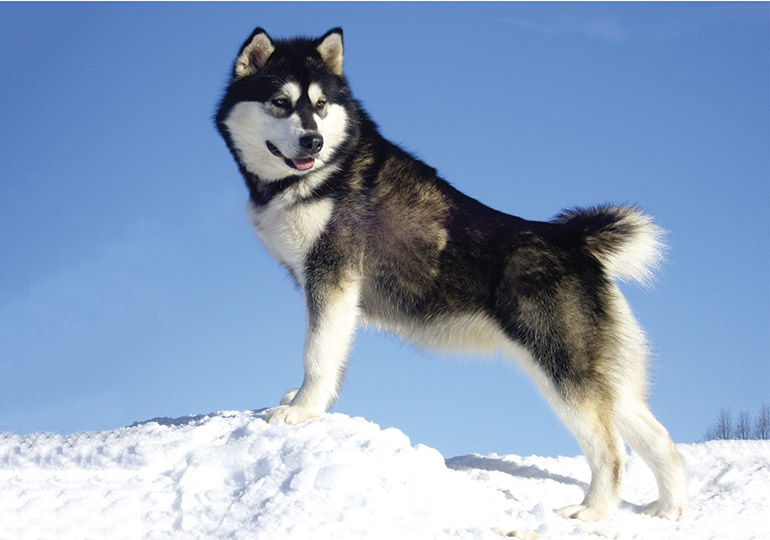Breeds
Alaskan Malamute

GROUP 6 - UTILITY
History
Some naturalists think the Alaskan Malamute is a product of the early dog and domesticated wolf from centuries ago, whereas some Eskimo cultural experts and a number of Eskimo elders dismiss this idea, pointing out the anatomical differences between dog and wolf.
Archaeological evidence indicates that Alaskan Malamutes may have first been used no more than three to five hundred years ago, although they may have been used for dog-drawn sleds or as pack dogs before that time. The Alaskan Malamute is an extremely hardy breed that was recognised by the AKC in 1935.
Characteristics
The phrase 'form follows function' applies to the Alaskan Malamute more so than any other breed. Every feature of the Alaskan Malamute relates to its function and its survival. The shape of its head, its top line, tail carriage, coat and colour help distinguish it from other Arctic sledding breeds, such as the Siberian Husky.
Appearance
The Alaskan Malamute is a powerful and substantially built breed with a deep chest and strong, well-muscled body. The breed's head is broad and the muzzle is bulky, only slightly diminishing in width from root to nose. Ears are triangular and erect when alerted. The Alaskan Malamute is made up of various colours: face markings are a distinguishing feature, consisting of a cap over the head, the face either all white or marked with a bar and/or mask.
Temperament
The Alaskan Malamute is a friendly, intelligent, independent dog that loves people. Because of this, it is not a guard dog, although its size and appearance makes the breed an effective visual deterrent. It is as strong-willed and determined as it is friendly and should have Obedience training from an early age.
Health
The Alaskan Malamute's average life span is 10 to 12 years, however, it does suffer from some health issues. These include Hip Dysplasia, Cataracts, Hypothyroidism (Thyroid), Polyneuropathy (DNA test available), Epilepsy and Bloat. Reputable breeders will test for these health issues.
Maintenance
The breed's coat may be medium or long in length and consists of two textures of dense hair, the outer coat and undercoat. Double-coated breeds do shed year round and routine brushing is the most important step in grooming the Alaskan Malamute.
Caution: do not shave your Alaskan Malamute in summer, as the hair that keeps the heat in, also keeps the heat out, and shaving could have long term effects. The breed usually sheds any unwanted hair in the warmer months.
Suitability
For those people looking for a dog with a lovable nature and outgoing personality, the Alaskan Malamute offers a lifetime of fun. The breed will insist on having a part in all family activities as it is a very pack-oriented breed and therefore does best when included in the family.
With this in mind, the Alaskan Malamute generally isn't a 'one man' dog. It is an extremely intelligent breed that can be very stubborn and easily bored, so it is not typically recommended for a first-time dog owner.
Words: Daniel Stevenson on behalf of the Alaskan Malamute Club of NSW Inc
In Conclusion
Now you know a little more about the Alaskan Malamute you may think that this is the dog for you. Before you make you make your decision, please make contact with the breed club or your State controlling body for purebred dogs. They will be able to give you information about available puppies and also suggest dog shows where you can see the breeds and speak to breeders. In this way you will gain a better perspective of the Alaskan Malamute and its needs and whether this breed would indeed suit your lifestyle.
Breeders



